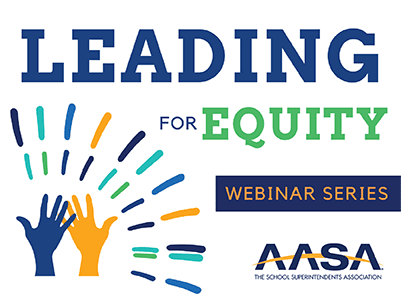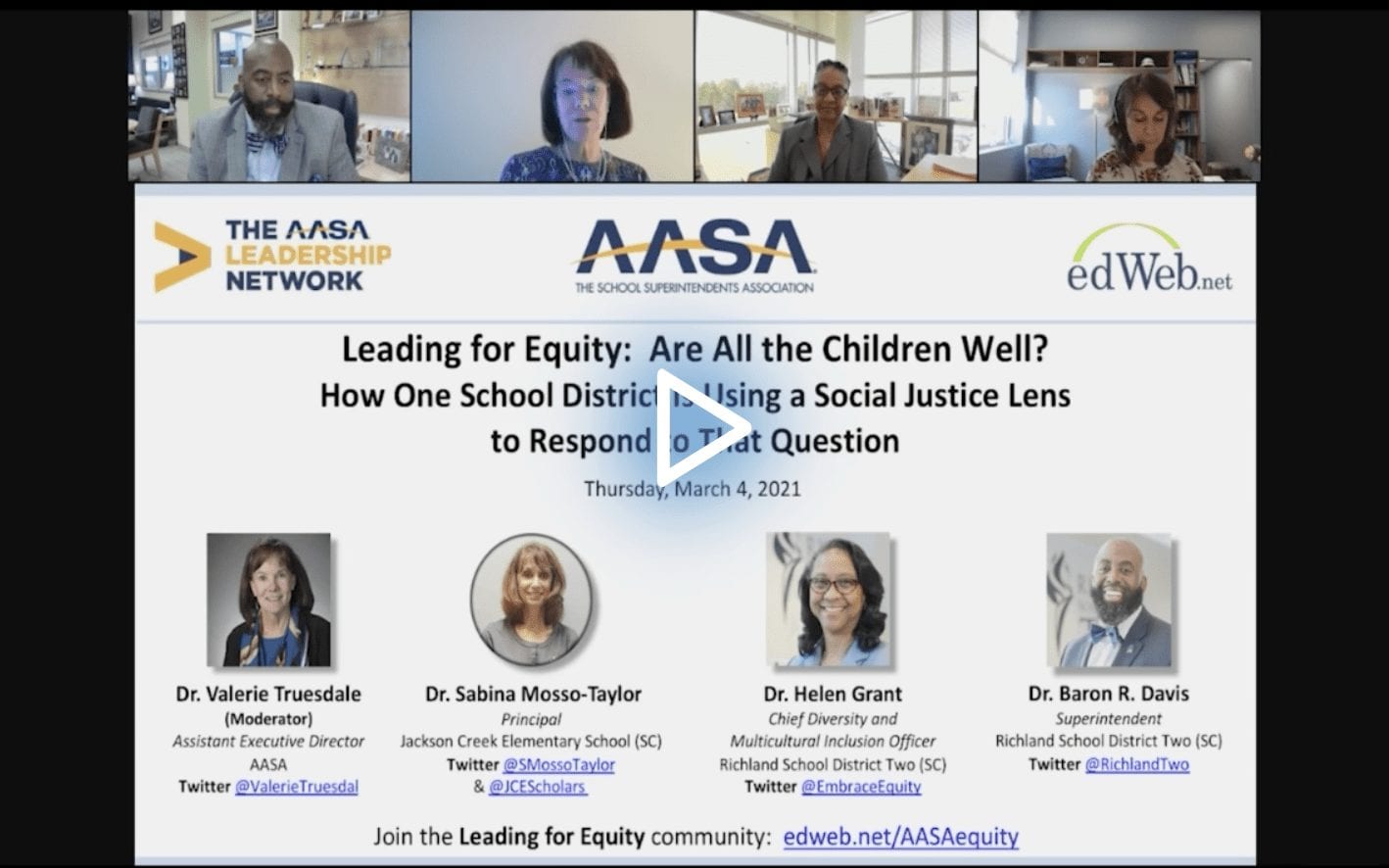Focusing on Social Justice as a Path to Equity
By Stacey Pusey
“How are the children?” That’s how Dr. Baron R. Davis, Superintendent of Richland School District Two (SC), starts every meeting. He isn’t just asking, though, if they are physically well. Like the traditional Maasai greeting, he’s asking if the people in his district are making the children their priority every day and making sure they are doing everything to take care of the children on every level.
That philosophy is also reflected in his district’s emphasis on viewing education through a social justice lens. In a recent edWebinar, hosted by AASA, The School Superintendents Association and AASA’s Leadership Network, Dr. Davis and his colleagues, Dr. Helen Grant, Chief Diversity and Multicultural Inclusion Officer, and Dr. Sabina Mosso-Taylor, Principal in the district, explained how their focus on social justice allows them to help every student achieve their potential.
As with any district-wide initiative, this focus begins with the strategic plan. But it wasn’t about adding social justice—rather they rewrote and simplified the plan so all constituents could see how their goals coalesced around the new mission. They started with four squares—learning, community, character, and joy—leading to five principles of practice meant to prepare children to be the global leaders of tomorrow: innovation, data-informed decisions, diversity and inclusion, partnering, and communication.
From these principles, they established three universal goals:
- Cultured environment: What does it look like in our district to respect and foster all students?
- Talent: How are we recruiting, developing, and retaining top, diverse talent, including teachers, staff, parents, and students?
- Achievement-oriented school: How does school look when the focus isn’t just on test scores but setting lofty goals and working towards them?
To meet these goals, they start with the perspective of advocacy for all, especially BIPOC, high-poverty, LGBTQ, religious, and other populations within their schools. This involves eliminating and dismantling systemic and systematic discriminatory practices and services that prevent students from receiving a premier educational experience. Moreover, Dr. Davis believes students can’t be global leaders if they don’t have a diverse perspective/experience and if they don’t subscribe to the power of inclusion.
Part of centering school operations around social justice meant asking key questions about current practices as well as anything they might potentially implement. For every program or initiative, school and district leaders ask:
- Is this culturally competent?
- Will it narrow achievement gaps between disaggregated student groups?
- Does it use a growth mindset?
- Will the students’ identities predict their success?
- Does this acknowledge and affirm the wide variety of ways students demonstrate mastery of skills and knowledge?
They’ve applied these questions to something seemingly insignificant like changing bus routes to more typical challenges like which students have access to which classes. This allows them to be intentional about spending resources (time and money).
In addition, the district has adopted values regarding how they view and interact with students:
- We must believe every student can achieve at the highest ability levels. High expectations are a priority because students need to know we believe they have the potential.
- We have to implement a growth mindset. If we don’t get a correct outcome the first time, we learn how to build on it and do better.
- Culturally relevant pedagogy is “good teaching” that must be implemented in each classroom. The goal should be to affirm students’ identities, promote their cultural background, see every student for the person they are, and let them bring their whole selves as a strength in the classroom.
- Each student should have mirrors and windows. Students should see someone like them who they can look up to as well as see someone different doing something they haven’t thought they could do before. Representation is also important in texts, stories, posters and pics on the walls, and the speakers they bring in.
- Brave and courageous conversations have to take place at each level of school district operations. This is how they avoid complacency and keep moving forward to meet the next students’ needs.
- Equity requires us to meet students where they are and help take them where they need to go to pursue their chosen pathway. If the goal is to help each student reach their potential, then educators need to understand where the students are starting and why.
Overall, Dr. Davis emphasized the importance of all members of the community embracing the social justice focus. “Equity: No more room for spectators,” he said, “[We] need everyone on the field to make a play.”
This edWeb broadcast was hosted by AASA, The School Superintendents Association and AASA’s Leadership Network, providing premier professional learning for educational leaders.
About the Presenters
Dr. Baron R. Davis
An educator for more than 20 years, Dr. Baron R. Davis is Richland School District Two’s Superintendent, and the first African American to hold this position in the district’s 90-plus-year history. Dr. Davis served a transition year as the superintendent-elect prior to assuming leadership of the district in 2017. In one of his first tasks as Superintendent, the 2017-2020 Strategic Plan, Dr. Davis lays out his vision for partnering with families, staff, and the community to make Richland Two the premier school district.
Dr. Davis has advanced the district’s long-standing commitment to providing superior learning experiences in top-notch facilities. Under his leadership, voters in Richland Two approved a request to borrow $468 million to address district facility needs in the areas of safety and security, academic learning spaces, transportation, technology, and arts/athletics. The bond referendum projects are part of a 10-year facility plan that provides a pathway to premier facilities across the district. Dr. Davis has opened doors for small and minority vendors to do business with Richland Two by hosting vendor fairs specifically for them.
Dr. Davis’s inclusionary practices led Richland Two to become one of only three districts in South Carolina and 250 nationwide to be placed on the 10th Annual AP® District Honor Roll by the College Board. To earn this distinction, Richland Two had to, since 2017, increase the number of students participating in Advanced Placement while also increasing or maintaining the percentage of students earning AP Exam scores of 3 or higher.
Dr. Davis has made increasing recruitment and retention of male teachers of color a priority by launching the Premier 100 initiative. About six percent of Richland Two’s teachers are male and minority. However, nationwide that number drops to less than two percent, despite the fact that the percentage of students of color continues to rise. Premier 100 partners with the Call Me MISTER program to recruit and retain male educators of color.
Dr. Helen Nelson Grant
In August 2015, Dr. Helen Nelson Grant became Richland Two’s first Chief Diversity and Multicultural Inclusion Officer. She is among the first to pioneer this work in K-12 public education in South Carolina.
In her role in the school district, Dr. Grant is responsible for recommending, developing, implementing, and managing programs and initiatives aimed at advancing diversity and multicultural inclusion. She serves as the chief advisor to the superintendent in the development and implementation of diversity and multicultural practices and initiatives and she is the district’s chief spokesperson and district representative for diversity and multicultural matters. Her work includes providing professional development to district staff, coordinating and implementing district-wide cultural celebrations, and advising administrators on issues or concerns regarding diversity and inclusion.
The Office of Diversity and Multicultural Inclusion facilitates Community Conversations, a series of events that bring together district families, employees, community members and business partners on a variety of topics impacting education. The Office also facilitates district-wide celebrations and recognitions including Hispanic Heritage Month, Black History Month, Women’s History Month, Kindness Month, and Inclusion Month.
Dr. Grant serves as the lead for Richland Two’s AASA 2020-2021 Equity in Action cohort and for the district’s Equity Work Group. She is a member of the district’s Opportunity/Knowledge Gap Task Force and she assists with the coordination of district initiatives to evaluate and promote more equitable systems, policies, and procedures.
Dr. Sabina Mosso-Taylor
Dr. Sabina Mosso-Taylor is an experienced principal with a demonstrated history of working in the education management industry. She is skilled in K-12 education, NBCT – EC Generalist, classroom management, lesson planning, differentiated instruction, culturally relevant teaching, and curriculum development. Dr. Mosso-Taylor is a strong education professional with a Doctor of Philosophy (Ph.D.) focused on early childhood education – early literacy from the University of South Carolina-Columbia. Currently, she is the principal of Jackson Creek Elementary School in Columbia, South Carolina.
About the Host
Dr. Valerie Truesdale joined AASA early in 2019 as the assistant executive director responsible for guiding leadership development services and programs. With years of experience in the superintendency and roles in instructional technology, she knows that AASA’s Leadership Network can be a substantial resource for school leaders trying to keep pace with the rapidly changing delivery of K-12 education.
Join the Community
Leading for Equity is a free professional learning community on edWeb.net for school and district leaders who face many challenges leading schools and driving school improvement for all students, especially now with COVID-19.
The AASA Leadership Network drives superintendent success, innovation, and growth, shaping the future of public education while preparing students for what’s next. We are the largest, most diverse network of superintendents in America. Passionate and committed, we connect educational leaders to the professional learning, leadership development, relationships, and partnerships they need to ensure a long career of impact.
Stacey Pusey is an education communications consultant and writer. She assists education organizations with content strategy and teaches writing at the college level. Stacey has worked in the preK-12 education world for 20 years, spending time on school management and working for education associations including the AAP PreK-12 Learning Group. Stacey is working with edWeb.net as a marketing communications advisor and writer.






Comments are closed.